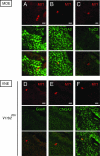A common gene exclusion mechanism used by two chemosensory systems
- PMID: 19200072
- PMCID: PMC3709462
- DOI: 10.1111/j.1460-9568.2009.06630.x
A common gene exclusion mechanism used by two chemosensory systems
Abstract
Sensory coding strategies within vertebrates involve the expression of a limited number of receptor types per sensory cell. In mice, each vomeronasal sensory neuron transcribes monoallelically a single V1R pheromone receptor gene, chosen from a large V1R repertoire. The nature of the signals leading to this strict receptor expression is unknown, but is apparently based on a negative feedback mechanism initiated by the transcription of the first randomly chosen functional V1R gene. We show, in vivo, that the genetic replacement of the V1rb2 pheromone receptor coding sequence by an unrelated one from the odorant receptor gene M71 maintains gene exclusion. The expression of this exogenous odorant receptor in vomeronasal neurons does not trigger the transcription of odorant receptor-associated signalling molecules. These results strongly suggest that despite the different odorant and vomeronasal receptor expression sites, function and transduction cascades, a common mechanism is used by these chemoreceptors to regulate their transcription.
Figures





Comment in
-
Non-exclusive exclusion (Commentary on Capello et al.).Eur J Neurosci. 2009 Feb;29(4):670. doi: 10.1111/j.1460-9568.2009.06658.x. Epub 2008 Feb 6. Eur J Neurosci. 2009. PMID: 19200069 Free PMC article. No abstract available.
References
-
- Belluscio L, Koentges G, Axel R, Dulac C. A map of pheromone receptor activation in the mammalian brain. Cell. 1999;97:209–220. - PubMed
-
- Boschat C, Pelofi C, Randin O, Roppolo D, Luscher C, Broillet MC, Rodriguez I. Pheromone detection mediated by a V1r vomeronasal receptor. Nat Neurosci. 2002;5:1261–1262. - PubMed
-
- Buck L, Axel R. A novel multigene family may encode odorant receptors: a molecular basis for odor recognition. Cell. 1991;65:175–187. - PubMed
-
- Cserzo M, Wallin E, Simon I, von Heijne G, Elofsson A. Prediction of transmembrane alpha-helices in prokaryotic membrane proteins: the dense alignment surface method. Protein Eng. 1997;10:673–676. - PubMed
Publication types
MeSH terms
Substances
Grants and funding
LinkOut - more resources
Full Text Sources
Molecular Biology Databases

